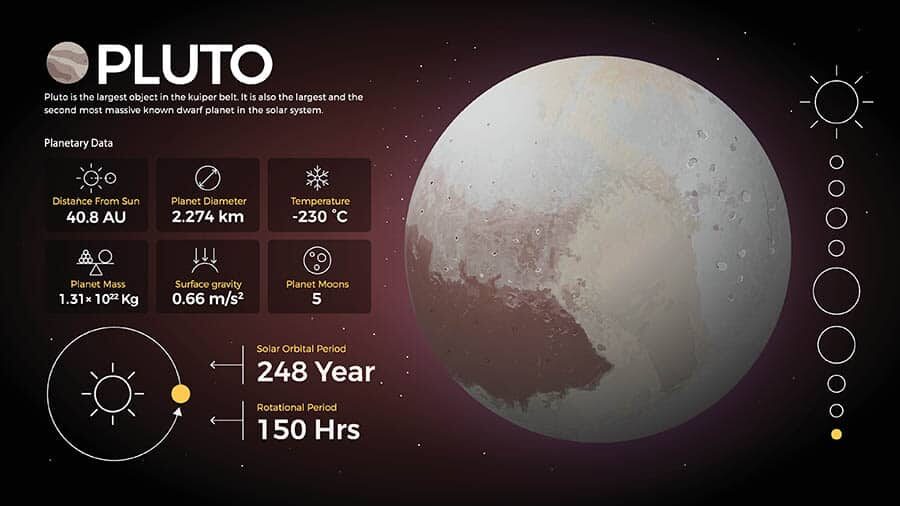16 Great Pluto Facts for Kids
When it comes to our solar system, not object is more misunderstood than Pluto. The demoted former 9th planet has been debated within astronomy circles for many years, but thanks to more advanced technology like the Hubble Space telescope, its since been reclassified as a dwarf planet.
If you’re wondering how big Pluto is and other interesting Pluto facts, then we’re going to run through some of this information in a second! Pluto is one of the five different dwarf planets out there, which don’t quite qualify as what we typically call a ‘planet’. We’ll discuss that too, but first let’s jump into some more interesting facts about Pluto.
- Pluto is named after the Roman God of the Underworld, also known as Hades in Greek Mythology.
- Pluto was discovered all the way back in 1930, which makes it older than many of the other dwarf planets. However, dwarf planet Ceres was actually founded back in 1801, so it’s not the oldest dwarf planet, despite what many people think!
- Pluto is located in the Kuiper Belt. The Kuiper Belt is a big ring around the Sun, kind of like a donut! 3 of the other dwarf planets are also located in the Kuiper Belt.
- It was generally accepted that Pluto was actually the ninth planet. However, this was reclassified back in 2006, and Pluto is now known as one of the biggest Dwarf planets!
- It takes Pluto an extremely long 248 years for it to complete one full orbit around the Sun!
- Another name for a dwarf planet is a Plutoid, named after Pluto – this is the case for all dwarf planets that are further from the sun than Neptune (Ceres isn’t!).
- Pluto is about two thirds the size of the Moon, and slightly bigger than the next biggest dwarf planet Eris.
- Pluto has five different moons, called Nix, Charon, Hydra, Styx and Kerberos. Charon is the largest of these moons.
- We only knew about three of these moons before the New Horizons space mission, which was a 10 year expedition. When there, astronomers discovered both Kerberos and Styx.
- The New Horizons expedition actually took some of Clyde Tombaugh’s ashes with them – that’s the astronomer who discovered Pluto back in 1930!
- A full day on Pluto is 6.4x the same length as an Earth day – it’s a massive 153 hours!
- This means that since we’ve known Pluto, it hasn’t completed a full orbit around the Sun. That’s because one year on Pluto is equal to 248 years on Earth.
- Even though Pluto seems like it might be good for human inhabitance due to it’s abundance of water, it’s unlikely that humans could ever live there due to it’s distance from the Sun.
- Although Pluto is quite large in comparison to other dwarf planets, it’s still tiny in comparison to the main planets – it’s not even as big as most of those planets moons!
- The atmosphere on Pluto comes and goes dependant on how close it gets to the sun!
- We think that Pluto’s reddish color is caused by its hydrocarbon molecules.
One of the most common questions that astronomers get is asking why Pluto is no longer classified as a planet. After all, many people learned to name their planets using a mnemonic device like “My Very Easy Method Just Speeds Up Naming Planets”, so to take away Pluto kind of ruins things!
The answer why Pluto isn’t classified as a planet is that is doesn’t “clear the neighbourhood” around it’s orbit. Astronomers reclassified what it was to be a planet back in 2006, which meant that every planet had to meet 3 different criteria to be classified as a planet.

To be named a planet, each object must; be in orbit around the sun, have enough mass to have a round shape (which we call hydrostatic equilibrium), and finally it needs to clear its neighbourhood. This means that in its orbit, it is the gravitationally dominant object, and there’s no other objects within its orbit.
For Pluto, this is ruined by two different things. Firstly, Neptune, which effects the gravity of Pluto. And secondly, with other dwarf planets within the Kuiper belt, like dwarf planet Haumea and dwarf planet Makemake.
Pluto was considered a planet, but with the discovery of Makemake and other objects in 2005, a new classification was set up for ‘dwarf planets’. Pluto fits this description, but not the technical description of a planet.
Pluto was discovered on Feb 18th all the way back in 1930. It was discovered by Clyde Tombaugh, who was an American astronomer. When Tombaugh discovered Pluto, he declared it the ninth planet from the sun, which is no longer the case.
As said earlier, Pluto gets it’s name from the Roman God of the undeworld. But, this was actually the idea of an 11 year old girl from Oxford, England named Venetia Burney. She said the name to her grandfather, who then suggested it to the observatory who discovered Pluto!
Although many people think Pluto is hot because of it’s reddish color, this isn’t actually the case. Remember, Pluto is a long way from the Sun, so it’s actually freezing cold!
Pluto actually isn’t a gas planet like Jupiter, Saturn, Uranus and Neptune. Unlike these gas planets, it’s made of rock and water (about 70% rock and 30% water, according to astronomers). At one point in time, Pluto was considered to be the farthest planet from the Sun, as it’s very far into the outer solar system and towards the Kuiper belt. However, it’s now considered a dwarf planet, so can’t be bunched in with the other gas giants.
All in all, these are just a few of the facts that we currently know about Pluto. We are learning more and more each day, so check back for new information or leave a comment if there’s an exciting new development! Pluto is one of the most interesting dwarf planets in existence, so it’s always fun to learn more about what’s out there!



